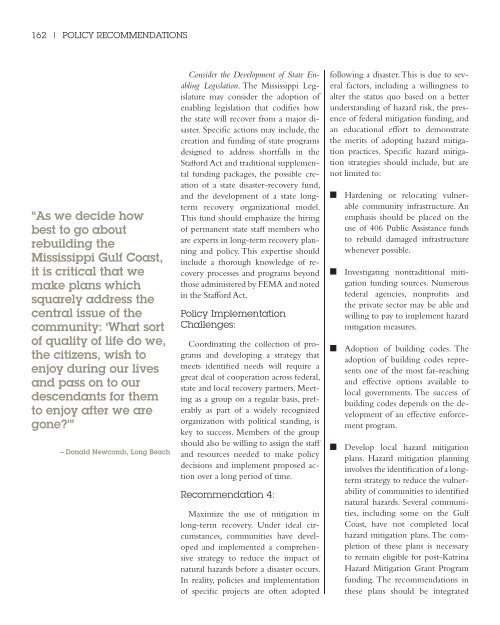Reports - Mississippi Renewal
Reports - Mississippi Renewal
Reports - Mississippi Renewal
- No tags were found...
You also want an ePaper? Increase the reach of your titles
YUMPU automatically turns print PDFs into web optimized ePapers that Google loves.
162 | POLICY RECOMMENDATIONS“As we decide howbest to go aboutrebuilding the<strong>Mississippi</strong> Gulf Coast,it is critical that wemake plans whichsquarely address thecentral issue of thecommunity: ‘What sortof quality of life do we,the citizens, wish toenjoy during our livesand pass on to ourdescendants for themto enjoy after we aregone?’”– Donald Newcomb, Long BeachConsider the Development of State EnablingLegislation. The <strong>Mississippi</strong> Legislaturemay consider the adoption ofenabling legislation that codifies howthe state will recover from a major disaster.Specific actions may include, thecreation and funding of state programsdesigned to address shortfalls in theStafford Act and traditional supplementalfunding packages, the possible creationof a state disaster-recovery fund,and the development of a state longtermrecovery organizational model.This fund should emphasize the hiringof permanent state staff members whoare experts in long-term recovery planningand policy. This expertise shouldinclude a thorough knowledge of recoveryprocesses and programs beyondthose administered by FEMA and notedin the Stafford Act.Policy ImplementationChallenges:Coordinating the collection of programsand developing a strategy thatmeets identified needs will require agreat deal of cooperation across federal,state and local recovery partners. Meetingas a group on a regular basis, preferablyas part of a widely recognizedorganization with political standing, iskey to success. Members of the groupshould also be willing to assign the staffand resources needed to make policydecisions and implement proposed actionover a long period of time.Recommendation 4:Maximize the use of mitigation inlong-term recovery. Under ideal circumstances,communities have developedand implemented a comprehensivestrategy to reduce the impact ofnatural hazards before a disaster occurs.In reality, policies and implementationof specific projects are often adoptedfollowing a disaster. This is due to severalfactors, including a willingness toalter the status quo based on a betterunderstanding of hazard risk, the presenceof federal mitigation funding, andan educational effort to demonstratethe merits of adopting hazard mitigationpractices. Specific hazard mitigationstrategies should include, but arenot limited to:■ Hardening or relocating vulnerablecommunity infrastructure. Anemphasis should be placed on theuse of 406 Public Assistance fundsto rebuild damaged infrastructurewhenever possible.■ Investigating nontraditional mitigationfunding sources. Numerousfederal agencies, nonprofits andthe private sector may be able andwilling to pay to implement hazardmitigation measures.■ Adoption of building codes. Theadoption of building codes representsone of the most far-reachingand effective options available tolocal governments. The success ofbuilding codes depends on the developmentof an effective enforcementprogram.■ Develop local hazard mitigationplans. Hazard mitigation planninginvolves the identification of a longtermstrategy to reduce the vulnerabilityof communities to identifiednatural hazards. Several communities,including some on the GulfCoast, have not completed localhazard mitigation plans. The completionof these plans is necessaryto remain eligible for post-KatrinaHazard Mitigation Grant Programfunding. The recommendations inthese plans should be integrated




